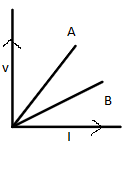Question
Question: V-I graph for two wires \[A\] and \[B\] are shown in the figure. If both wires are of the same lengt...
V-I graph for two wires A and B are shown in the figure. If both wires are of the same length and same thickness. which of two is made of material of high resistivity? Give justification for your answer.

Solution
The V−I Characteristic Curves is the short form of Voltage - Current. V−I characteristic curves used as a tool to define and understand the basic parameters of a component. This V−I graph determines the relation between current flows in an electronic device and voltage applied across its ends. The Voltage- current graph gets valuable information about the resistance and breaks down an electronic device and it explains electrical or electronic device operates.
Formula used:
To find voltage multiply current and resistance.
V=IR
Complete step by step answer:
Greater will be the resistance of a metallic wire if greater than the slope of V−I the graph. In the V−I graph, the wire A has a greater slope than B slope. Hence, greater resistance in wire A.
Resistance depends on the nature of the material of the metallic wire for the wires of the same length and same thickness.
This graph is defined using ohm’s law,V=IR here V is voltage, I is current, and R is resistance.
The current or I=RV whereas I that is current.
The gradient of the wire A has a higher inclination hence the gradient is higher than that of the wire B. Current flowing is directly proportional to the voltage V and inversely proportional to the r resistance
Note: V−Iand I−V the graph shows the relationship between current and voltage.
In V−I graph, we take V as x axis and I as y axis
But in the I−V graph, we take I as the x axis and V as y axis.
The slope of the V−I graph provides resistance as a result. Reciprocal Slope of I−V graph provides resistance.
